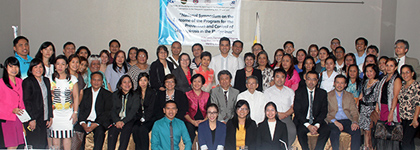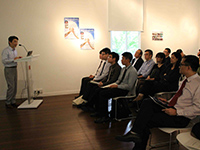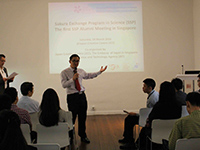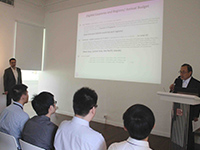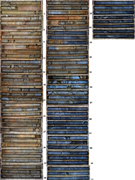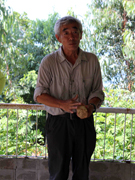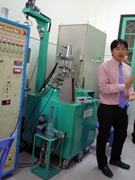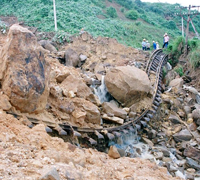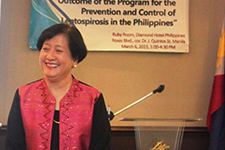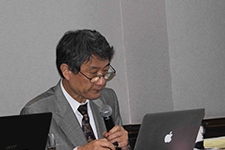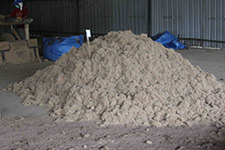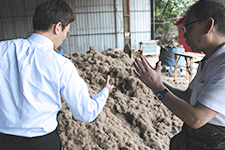In brief, “Leptospirosis” is a zoonotic infectious disease with a worldwide distribution in tropical and subtropical regions, causing multiple organ failures ? including jaundice, renal failure and pulmonary hemorrhage in humans. Rats are considered its main vectors, although other infected animals such as dogs, cows, carabaos and pigs could excrete the bacteria through their urine and contaminate the environment. Usually, the disease breaks out in regions where hygiene or sanitation is bad.
Which is why Dr. YANAGIHARA instigated a research project into the disease which has recently concluded its first five-year term in the Philippines. The project, titled “Prevention and Control of Leptospirosis in the Philippines”, otherwise known as LepCon, and supported by JST and JICA under the SATREPS banner (Science and Technology Research Partnership for Sustainable Development), was led by Dr. Nina GLORIANI of the University of Philippines Manila and Dr. Shinichi YOSHIDA of Kyushu University, Japan.
However, despite finishing its five-year term in 2015, the importance of the battle against Leptospirosis cannot be understated, and therefore the research team has been asked to continue its fight against the disease.
And so it was with that in mind that I had the opportunity to sit down with the project leader of LepCon, Dr. Nina GLORIANI, in March 2015 at the “National Symposium on the Outcome of the Program for the Control and Prevention of Leptospirosis in the Philippines”, to hear about the work she has been doing with Dr. YOSHIDA under the guidance of Dr. YANAGIHARA.
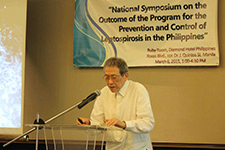
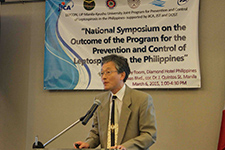
1. How did you get involved in LepCon project?
I have been working with Dr. Yasutake YANAGIHARA since 1998 when he first came to UP Manila on a JST grant for Leptospirosis research in the Philippines. Through this JST grant, we were able to establish a small laboratory capable of confirming diagnosis of Leptospirosis.
This grant was for three years, and ended in 2001. Another opportunity came in 2006-2009 when Dr. Shinichi YOSHIDA at Kyushu Universtiy, again through YANAGIHARA Sensei (meaning Dr.), brought a small MEXT grant to continue small projects on Leptospirosis in the Philippines. Together with YOSHIDA Sensei, YANAGIHARA Sensei, and MASUZAWA Sensei, a five-year program proposal for the Prevention and Control of Leptospirosis in collaboration with Kyushu University and the Chiba Institute of Science was submitted to JICA which was subsequently approved for implementation in 2010 as a SATREPS project ? otherwise known as “LepCon”.
My involvement in the LepCon project, I would attribute to my field of specialization which is Medical Microbiology and Microbial Immunology and my long term collaboration with YANAGIHARA Sensei. It also coincided with my term as Dean of the College of Public Health, which allowed me to provide overall supervision as well as technical expertise from the local side.
2. What was the scope of your research before you joined the project?
Before the LepCon project started in 2010, prevalence studies on Leptospirosis were conducted on a small scale that included human referrals from a few hospitals, testing animals and isolating the Leptospira from environmental soil/water samples.
3. With whom did you discuss the submission of the proposal?
The proposal was the product of several discussions with the three professors, with input from other Japanese scientists as well. From the Philippine side, I contributed most of the input, with consultative meetings with key faculty who could potentially get involved. We also considered the laboratory capabilities then at the department of medical microbiology where the project was planned to be based.
4. Could you tell us the condition of Leptospirosis in Philippines before the project was launched?
Before the LepCon project was launched, laboratory confirmation of suspect Leptospirosis cases was primarily done by the Research Institute for Tropical Medicine (RITM), the referral center of the Department of Health for emerging and re-emerging infectious diseases. However, most of the cases reported from various regions were only clinically diagnosed, as RITM also had its limitations in conducting laboratory confirmatory tests, especially during surge of cases following typhoons and floodings.
5. What was a big issue about an epidemic when the project began?
The LepCon project began officially in April 2010. In September 2009, a big typhoon named Ondoy (otherwise known as Ketsana) hit the Philippines and submerged many parts of Metro Manila and suburbs in deep flood up to three stories high, causing big outbreaks of Leptospirosis in many areas affected. Such occurrences further highlighted the need to put in place a program that will address the prevention and control of Leptospirosis on a wider scale, and in a more pro-active manner.
6. After the project started, what was the challenge you faced?
The initial challenge we faced was to establish a network with government agencies. In particular, to establish a system for referring suspect Leptospirosis cases to our laboratory. Collaboration with DOH sentinel sites was slow at first, but later on improved, with the help of National Epidemiology Center (NEC) Director, Dr. Eric Tayag, and the officials of the Local Government Units (LGUs). During project implementation, we also faced problems with some lengthy administrative policies in academe and government but these were eventually successfully resolved.
7. In addition to the project’s goals, what kind of achievement did you get?
Aside from the goals and objectives that we set and for which we have accomplished much, the greatest achievement by far is that we were able to bring down to the community level, the research processes and results, for the benefit of the Filipino people.
The relationship between UP Manila as an academic institution and various levels of governance in health, science and technology has also been improved. Technical cooperation with the Japanese scientists was excellent and the interaction fostered good professional and personal relations which are all critical to any successful project outcome.
The capacity-building component of the LepCon program in terms of human resource development was one of the best things that happened. Our faculty and staff, including students, were trained in new, advanced techniques both in Japan (counterpart training) and in the renovated LepCon laboratory in the college. More students are now able to use the laboratory facilities for their special studies, research subjects, thesis and dissertations.
The program implementation itself was a test of perseverance, understanding, negotiation skills and many other learnings about interpersonal interactions, flexibility and openness to all possibilities and opportunities for growth and expansion beyond the initial plans. We met other experts, stakeholders, and in the process, opened up a lot of opportunities and possibilities for our faculty and staff, our students, and our partners at the grassroots level.
8. What do you think about SATREPS, the program itself?
SATREPS is a great program by itself, catering to the needs of underdeveloped countries to enhance their capabilities in various areas, through Japanese and recipient country-counterpart cooperation. It is based on mutual understanding, respect and desire to improve lives and health of communities.
9. What is the most memorable part of this five-year project for you?
The entire program development from proposal preparation to defending it in Tokyo JICA HQs, to its implementation, monitoring progress, meeting timelines and deliverables, including mid-term and up to terminal evaluation has been a great experience I will never forget. Each step of the way had its own challenges, and surmounting the difficulties was reward by itself.
10. What is the next step?
We have laid out sustainability plans to continue the project beyond JICA and JST-SATREPS support. Two big DOST-PCHRD projects will continue on to 2016. The DOH-NEC also has been requested to provide support to LepCon for continued human leptospirosis surveillance through the Philippine Integrated Disease Surveillance and Response (PIDSR). We also have plans to submit additional project proposals for human, animal and environmental surveillance for this neglected disease, but also will consider branching out to other pathogens. Some initial discussions with other potential partners, also from Japan, the UK and from the USA have been made.
11. What is the reaction of Philippine government towards the project and its outcome so far?
At this point in time, and perhaps for the last two-to-three years, the agencies we worked with appreciated the service we were doing for the laboratory diagnosis of Leptospirosis cases.
The DOH-NEC slowly accepted the assistance we offered them which help confirm Leptospirosis cases, contributing to more evidence-based statistics.The Department of Science and Technology ? Philippine Council for Health Research and Development (DOST-PCHRD), also recognized the value of what we were doing in terms of research and extension services to the community.
Through this project, I observed the strong bond among researchers beyond nations and cultures. I believe that achievement was made because of their mutual scope: making people’s lives better. Dr. YOSHIDA retired from the university as he completed the 5-year LepCon. When I met him at the conference, he showed his continuous motivation towards the eradication of the disease. At the last, he added “This would not have been done without the long-term dedication of Dr. YANAGIHARA to the research, and I would simply like to support his dream that the disease can be eradicated.” Their efforts will continue.
There are many diseases still roaming without certain cure in the Third-world where living environments are being devastated. Most of them are being neglected by advanced medical technology and services which people in the First-world countries have access to. And that’s why diseases like Leptospirosis are called “Neglected Tropical Diseases (NTDs).” And even at this moment researchers are fighting against them all over the planet.
